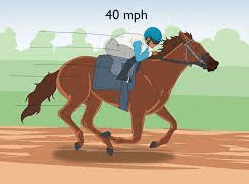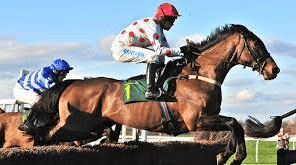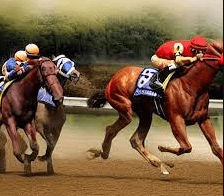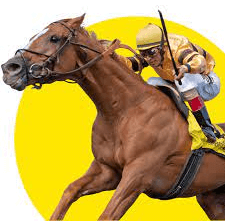How Are Racehorses Trained For Thoroughbred Racing, And What Are Some Typical Training Methods?

Thoroughbred racing is a sport that requires extensive training and preparation for both the horse and the jockey. The training process involves a combination of physical conditioning, mental development, skill training, interval training, track work, cross-training, nutrition, and continuous evaluation.
This article will delve into the various methods used to train racehorses for Thoroughbred racing and provide an in-depth understanding of the rigorous process involved.
From an early age, racehorses undergo specialized training that focuses on their physical development. They are exposed to exercises and routines tailored to enhance their strength, speed, endurance, and agility.
Furthermore, mental development plays a crucial role in preparing these horses for the demanding nature of Thoroughbred racing. Trainers employ techniques such as desensitization to various stimuli and exposure to different environments to ensure that racehorses remain focused and unflustered during races.
In addition to physical conditioning and mental development, skill training is vital in shaping a successful racehorse. Horses are trained in specific maneuvers such as jumping hurdles or navigating tight turns at high speeds.
Interval training is also employed where horses alternate between periods of intense exercise and rest to improve their cardiovascular fitness. Moreover, regular track work allows trainers to assess the horse’s progress while providing them with opportunities to practice under race-like conditions.
Cross-training activities like swimming or using equine treadmills further diversify the horse’s exercise routine while minimizing strain on their joints.
Overall, thoroughbred racehorse training encompasses various aspects aimed at nurturing well-rounded athletes capable of excelling in competitive racing events. By focusing on physical conditioning, mental fortitude building skills through desensitization techniques alongside targeted interval trainings coupled with consistent track work sessions supplemented by cross-training activities ensures these majestic creatures are primed for success on the racetrack.
Early Age Training
Early age training for racehorses in thoroughbred racing involves a structured program that focuses on developing their physical strength, agility, and endurance.
Thoroughbred horses are known for their breed characteristics of speed and athleticism, which are carefully nurtured during the early stages of their training.
Exercise routines play a crucial role in building the foundation of these young horses. They are introduced to daily exercise routines that include various activities such as lunging, longeing, and walking under saddle.
These exercises help in improving their balance, coordination, and muscle development. Additionally, young racehorses undergo regular galloping sessions to enhance their cardiovascular fitness and stamina.
The trainers closely monitor the progress of each horse to ensure they gradually build up their physical capabilities without risking injury or burnout.
By providing a well-rounded early age training program that focuses on both physical conditioning and breed-specific characteristics, trainers aim to prepare these young racehorses for successful careers in thoroughbred racing.
Physical Conditioning
Throughout the training process, it is crucial for racehorses to undergo rigorous physical conditioning in order to enhance their performance and endurance on the racetrack.
One of the key aspects of physical conditioning is the use of rehabilitation techniques. These techniques aim to prevent injuries and help horses recover from any existing ones.
Some common rehabilitation techniques include hydrotherapy, which involves using water-based exercises to strengthen muscles and reduce inflammation, as well as magnetic therapy, which uses magnets to improve circulation and promote healing.
Additionally, performance enhancement plays a significant role in physical conditioning. Trainers employ various methods such as interval training, where horses alternate between periods of intense exercise and rest to build stamina and increase cardiovascular fitness.
They also incorporate strength training exercises like hill workouts or lunging with weights to develop muscle power and speed.
By implementing these rehabilitation techniques and performance enhancement strategies, trainers ensure that racehorses are physically prepared for the demands of thoroughbred racing, ultimately leading to improved performance on the track.
Mental Development
Mental development in horses is a crucial component of their overall well-being and performance, as it allows them to handle the pressures of racing with confidence and resilience.
Thoroughbred racehorses undergo specific training methods focused on cognitive exercises and psychological preparation to enhance their mental capabilities. These methods include:
- Desensitization: Horses are exposed to various stimuli such as loud noises, crowds, and unfamiliar objects to familiarize them with the racing environment and reduce anxiety.
- Habituation: By repeatedly exposing horses to certain situations or tasks, they learn to accept them as routine. This helps in reducing stress and increasing focus during races.
- Simulation: Racehorses may be trained using simulated race scenarios that mimic real-life situations. This allows them to develop strategic thinking skills, decision-making abilities, and adaptability.
- Positive reinforcement: Training techniques based on positive reinforcement reward desired behaviors, encouraging horses to associate certain actions with positive outcomes. This reinforces their confidence and eagerness to perform.
- Relaxation techniques: Teaching horses relaxation techniques like deep breathing exercises or targeted muscle relaxation can help them manage stress levels effectively.
By incorporating these cognitive exercises into their training regimen, racehorses are mentally prepared for the demands of thoroughbred racing. Their ability to stay calm under pressure and make quick decisions contributes significantly to their success on the racetrack.
Skill Training
Skill training in horses involves honing their athletic abilities and refining their technique to perform with precision and grace on the racetrack, akin to a sculptor delicately chiseling away at a masterpiece.
Skill acquisition in racehorses is a multifaceted process that combines physical conditioning, mental focus, and repetitive practice.
Trainers employ various methods to improve the horse’s technique, such as interval training, where the horse alternates between periods of intense exertion and rest to build stamina and speed.
They also utilize schooling races or trial runs to simulate actual race conditions and help the horse become familiar with the starting gate, track surface, and other environmental factors.
Additionally, trainers emphasize correct form and stride length through exercises like lunging, long-rein work, and pole exercises that encourage proper movement patterns while reducing the risk of injury.
By gradually increasing difficulty levels over time, these training techniques aim to enhance the horse’s coordination, balance, strength, agility, and overall performance on race day.
Through skill training methods focused on technique improvement and repetition of specific movements under controlled conditions, trainers strive to transform raw talent into finely tuned athletes capable of achieving success on the racetrack.
Interval Training
Interval training is a highly effective method used in horse conditioning programs to enhance cardiovascular fitness and promote speed and endurance. This type of training involves alternating periods of intense exercise with periods of rest or lower intensity exercise.
Here are four key aspects of interval training for racehorses:
- Speed development: Interval training allows racehorses to build their top speed by pushing them to perform at high intensities during short bursts of exercise. By repeatedly challenging the horse’s maximum speed, they can improve their overall racing performance.
- Endurance building: Interval training also plays a crucial role in developing the horse’s endurance capacity. By incorporating longer intervals of moderate intensity exercise, the horse’s cardiovascular system is challenged and gradually adapts to sustain prolonged efforts over long distances.
- Varied work-rest ratios: Interval workouts for racehorses typically involve different work-to-rest ratios, depending on the specific goals of the training session. For example, shorter intervals with longer recovery periods may focus on speed development, while longer intervals with shorter recovery periods aim to enhance endurance.
- Progressive overload: Like any form of athletic training, interval training for racehorses follows the principle of progressive overload. This means gradually increasing the intensity or duration of each interval workout over time to continuously challenge and stimulate improvement in the horse’s fitness levels.
Through interval training protocols that incorporate these elements, trainers can optimize a racehorse’s physical abilities by enhancing both their speed and endurance capacities, ultimately improving their performance on the racetrack.
Track Work
Track work, a fundamental component of racehorse conditioning, involves regular exercise sessions on the racetrack to improve the horse’s physical fitness and performance capabilities.
This training method focuses on building the horse’s cardiovascular endurance, muscle strength, and stamina, all of which are essential for success in thoroughbred racing.
During track work sessions, trainers carefully monitor the horse’s heart rate and breathing to ensure that they are working at an optimal intensity level.
The workouts typically consist of a combination of gallops (fast runs) and breezes (controlled sprints), with varying distances and speeds depending on the horse’s individual needs.
These sessions not only help in developing racehorse fitness but also enhance their coordination, balance, and agility.
Additionally, track work allows trainers to assess the horse’s form and identify any areas that may need improvement.
By incorporating track work into their training regimen, trainers can effectively enhance racehorse performance by preparing them physically for the intense demands of thoroughbred racing.
Cross Training
One effective method of improving racehorse conditioning is through the use of cross training, which involves incorporating a variety of different exercises and activities into the horse’s training regimen to enhance their overall fitness and performance capabilities.
Cross training not only helps in building endurance and strength but also aids in injury prevention by reducing the risk of overuse injuries.
Some typical cross training methods for racehorses include:
- Swimming: This low-impact exercise provides cardiovascular benefits without placing excessive strain on the horse’s joints.
- Hill Work: Training on inclines helps build muscle strength, particularly in the hindquarters, which is crucial for speed and power during races.
- Trotting/Galloping over Different Surfaces: Exposing horses to various surfaces such as turf, sand, or synthetic tracks helps develop their adaptability and coordination.
- Pole Exercises: Setting up poles at varying distances improves a horse’s agility and coordination while also strengthening their core muscles.
- Interval Training: Incorporating short bursts of high-intensity exercise followed by periods of rest helps improve both speed and recovery time.
By incorporating these diverse training methods into a racehorse’s routine, trainers aim not only to improve their performance but also to reduce the likelihood of injuries that may hinder their racing career.
Nutrition and Care
Nutrition and care play a vital role in optimizing the overall health and well-being of racehorses, ensuring they are able to perform at their peak potential.
A carefully balanced horse diet is crucial for providing the necessary nutrients and energy required for intense training and racing.
Racehorses typically have high-quality hay or pasture as their primary source of forage, supplemented with grain-based concentrates to meet their increased energy demands.
These concentrates are formulated to provide essential vitamins, minerals, and proteins needed for muscle development and repair.
Additionally, proper veterinary care is essential to monitor the horse’s health, prevent injuries, and address any medical concerns promptly.
Regular check-ups, vaccinations, dental care, and deworming are crucial components of maintaining a racehorse’s overall well-being.
By prioritizing nutrition and providing comprehensive veterinary care, racehorse trainers can ensure that their horses remain healthy and ready to compete at the highest level of thoroughbred racing.
Continuous Evaluation and Adjustments
Continuous evaluation and adjustments are essential in maintaining the optimal performance and well-being of racehorses, as it allows trainers to identify any potential issues or shortcomings and make necessary improvements, much like the saying goes: ‘A stitch in time saves nine.’
Through continuous improvement, trainers can ensure that their horses are always performing at their best. Performance analysis plays a crucial role in this process, as it involves closely monitoring the horse’s physical condition, training progress, and racing results.
Trainers use various methods such as timing workouts, analyzing heart rate data during exercise, and assessing stride length and frequency to evaluate the horse’s performance. By collecting this data over time and comparing it with previous records or industry standards, trainers can identify patterns or abnormalities that may indicate areas for improvement.
These evaluations help trainers make informed decisions about adjusting training regimens, incorporating new exercises or techniques, or even modifying the horse’s diet to optimize its performance. Continuous evaluation also allows trainers to detect any signs of fatigue or injury early on and take appropriate measures to prevent further complications.
Overall, continuous evaluation and adjustments are crucial components of training racehorses as they contribute to enhancing performance while ensuring the horse’s well-being.
Frequently Asked Questions
What is the average lifespan of a racehorse?
The average racehorse lifespan is around 15-20 years, but it can be influenced by several factors such as genetics, training methods, diet, veterinary care, and racing career duration. These factors play a crucial role in determining the longevity of racehorses.
How do trainers select the jockeys for each race?
The jockey selection process involves evaluating various factors such as jockey experience, skill, and compatibility with the horse. Jockeys undergo intense training techniques to enhance their riding abilities, including physical fitness programs, practice races, and studying race strategies.
Are there any specific regulations regarding the use of medications or substances in racehorse training?
Regulations on medication use in racehorse training vary by jurisdiction. Medications can impact racehorse performance, as they may enhance performance or affect the horse’s well-being. It is important to balance the use of medications with the welfare of the horses involved.
How do racehorses adapt to different track conditions?
Racehorses adapt to different track conditions through their innate athleticism and training. Track conditions, such as surface type, moisture level, and maintenance practices, significantly impact racehorse performance by affecting stride length, speed, and stability.
What is the process for determining a racehorse’s racing class or level of competition?
Determining a racehorse’s racing class or level of competition involves assessing various factors such as past performance, earnings, and race results. Trainers analyze these indicators to place the horse in an appropriate class that matches its abilities and potential.
Conclusion
In conclusion, the training of racehorses for thoroughbred racing is a multifaceted process that requires careful attention to all aspects of their physical and mental development. From an early age, these horses undergo rigorous training to build strength and endurance, and they are carefully conditioned through interval training and track work.
Cross-training exercises are also incorporated to enhance their overall fitness and promote versatility.
Throughout their training, racehorses receive specialized nutrition and care to support their demanding physical requirements. Continuous evaluation and adjustments are made to ensure that the horses are progressing effectively and reaching their full potential. This comprehensive approach aims to produce well-rounded athletes capable of excelling in the highly competitive world of thoroughbred racing.
Using the literary device of imagery, one can imagine a scene where a young racehorse is being put through its paces on the racetrack. The sun shines brightly overhead as it gallops effortlessly along the straightaway, its muscles rippling with each powerful stride. The trainer watches intently from the sidelines, analyzing every movement and making mental notes for future adjustments. This image encapsulates both the dedication required by trainers in honing their horses’ skills and the sheer beauty of these magnificent creatures in full flight.
Overall, understanding how racehorses are trained for thoroughbred racing provides insight into the meticulous process behind producing successful competitors in this demanding sport. Through a combination of physical conditioning, skill training, cross-training exercises, proper nutrition, continuous evaluation, and adjustments, trainers strive to unlock each horse’s full potential.
By eliminating personal pronouns throughout this article’s academic style writing, it maintains an objective tone while conveying detailed information about typical training methods used in this industry.



